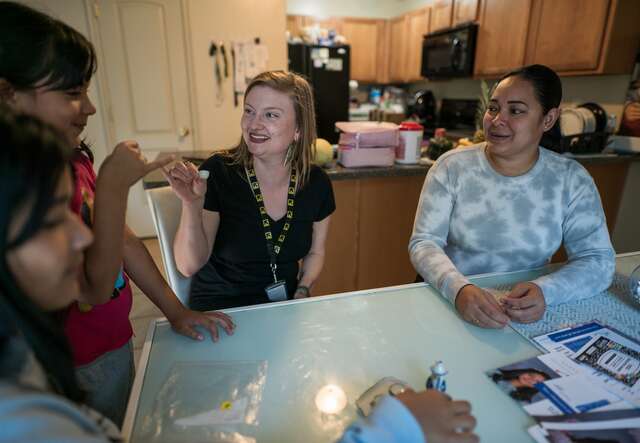
What happens once asylum seekers arrive in the U.S.?
People seeking asylum in the U.S. face case processing delays on their asylum applications and barriers to employment. Let’s take a closer look at these challenges.

People seeking asylum in the U.S. face case processing delays on their asylum applications and barriers to employment. Let’s take a closer look at these challenges.
The United States has a proud history of providing safety to people fleeing violence and persecution. The act of seeking asylum is a legal right protected under international and domestic U.S. law. Asylum provides a lifeline to those fleeing dangerous situations in their countries of origin even if that often means undertaking perilous journeys to get refuge.
Currently, some people who have arrived at the U.S. border and have sought asylum protection are facing extended waiting periods—up to seven years in some cases—for their application to be adjudicated. Meanwhile, restrictions on the right to work and limited access to assistance programs, make it nearly impossible for asylum seekers to support themselves and their families.
U.S. Congress should allow asylum seekers to contribute to the nation’s economy by expediting the work permit application process so that they do not need to rely on others for support as they rebuild their lives.
People who have fled their homes in search of safety or protection can seek asylum once they are physically present in the U.S. or at a port of entry, such as an airport or official land crossing. Asylum seekers must demonstrate to authorities that they are unable or unwilling to return to their country of origin because of persecution or a well-founded fear of persecution on account of race, religion, nationality, membership of a particular social group or political opinion.
Learn more about how people seek asylum in the U.S.

There are currently more than two million pending asylum cases in the U.S. The backlog of asylum cases has led to unprecedented waiting times, forcing asylum seekers to endure waits of up to seven years. This backlog separates asylum-seekers from family members stranded abroad, interferes with integration opportunities and damages the credibility of the U.S. asylum system.
Congressional leadership should address the asylum backlog that leaves people seeking protection waiting years for decisions by scaling funding to onboard additional asylum officers and judges. The U.S. must work to improve the speed of fair adjudications, without sacrificing the due process guarantees integral to a safe, humane and orderly asylum system.
Urge President Biden to protect the rights of asylum seekers.
Asylum seekers are generally not eligible to apply for services delivered by the Office of Refugee Resettlement (ORR), the federal entity tasked with providing support to refugees in the U.S. Exceptions exist for unaccompanied children who are seeking asylum and survivors of torture, who are eligible for some services.
Asylum seekers are also generally not eligible for federal public benefits, including cash assistance, food stamps, and social security. There are limited exceptions for emergency medical services, disaster relief, public health immunizations and other emergency programs. Fortunately, a few states provide access to health insurance and other limited support to asylum seekers via local and state-led programs.
Nonprofits and NGOs, like the IRC, can step in and support asylum seekers in the U.S. as they await the adjudication of their asylum applications through information and legal services and case management programs.

Currently, asylum applicants have to apply for employment authorization and wait at least 180 days for a work permit. When people seeking asylum come to the U.S., they want to support themselves and their families rather than rely on humanitarian support as they rebuild their lives and integrate into their new communities.
Employers and host communities can also benefit from expedited work permits to meet the needs of an aging workforce and labor shortages, filling critical gaps in the labor market. The current 180-day wait for employment authorization limits the ability of asylum seekers to provide for themselves and their families and increases their risk of exploitation or other abusive situations, including human trafficking.

The Asylum Seeker Work Authorization Act (H.R. 1325) is a bipartisan bill that would bolster the U.S. workforce by allowing would-be workers who have pending asylum applications to access their work permits sooner—from 180 days to 30 days—and reduce obstacles in maintaining their work authorization.
This act would strengthen the country’s workforce and enable asylum seekers to better provide for their families as they wait for a decision on their application for asylum.
President Biden issued a proclamation under sections 212(f) and 215(a) of the Immigration and Nationality Act temporarily suspending asylum as of midnight on June 4th, 2024. This applies to anyone arriving at the southern border unless they have a CBP One appointment at an official port of entry.
The suspension, which was amended on September 30th, will stay in effect until daily southern border encounters drop below 1,500 on average for 28 consecutive days. Daily southern border encounters have not fallen below 1,500 over an extended period of time since 2020, during the COVID-19 pandemic.
Encounters don't count people who arrive at a port of entry. However, the updated order now includes unaccompanied children in the calculation for daily encounter averages even though they will remain exempt from the suspension and related measures.
These actions are harmful, counterproductive, and illegal. The IRC urges the Biden Administration to reconsider these executive actions that restrict asylum and violate U.S. refugee protection standards. These measures lead to increased misinformation and exploitation by criminal actors and force asylum seekers into more dangerous routes, jeopardizing their lives while further undermining the asylum system.
“America’s asylum system needs upgrading to adapt to historic levels of global displacement and address the humanitarian challenges host communities face,” says IRC senior vice president for resettlement, asylum and integration Hans Van de Weerd.
"Restricting the right to seek asylum violates U.S. refugee law and sends a counterproductive message to other countries hosting people seeking safety that refugees can be turned away at will."
In fiscal year 2023, the IRC’s Asylum and Crossborder programs served nearly 50,000 people in need of protection in the U.S., with a warm welcome, case management and emergency assistance. Our Welcome Center provides humanitarian reception for asylum seekers, including food, shelter, clothes, safe play areas for children, legal orientation, medical screening and travel assistance.
The IRC has also launched critical information services for asylum seekers and vulnerable communities: InfoPa’lante in Colombia, CuéntaNos in northern Central America and InfoDigna in Mexico are all part of our global Signpost project with partners including Mercy Corps, Google, Microsoft, Twilio, Cisco, Tripadvisor and Box. The digital platform includes an interactive map that connects asylum seekers and other displaced people to shelters, health care providers and other services. An additional service, ImportaMi, serves unaccompanied children who recently arrived in the U.S.

Donate to help the IRC provide critical aid to refugees and asylum seekers worldwide.
Support the Let Asylum Seekers Work Campaign.
Learn about more ways you can help support refugees and asylum seekers at the US-Mexico border.